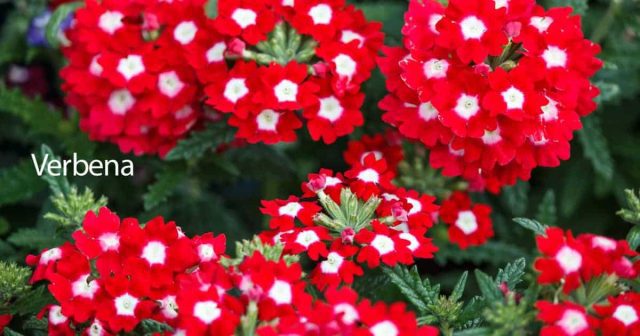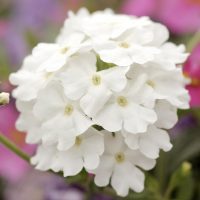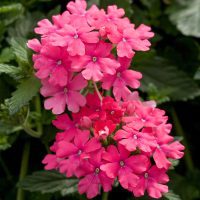Verbena is the ideal plant to cascade over retaining walls, containers, baskets, and window boxes. As long as its soil is well drained, verbena will reward gardeners with countless clusters blooms all season long. Verbena is also drought tolerant, making it a great choice for rock gardens and for planting in cracks between stones.
Colorful Combinations
The more common verbenas are generally a hybrid of many different species to make the common varieties you see today. However, there is another commonly planted verbena, Verbena bonariensis. V. bonariensis or purpletop vervain, is a wonderfully versatile annual. Unlike the more common verbena, the purpletop vervain is very tall. These plants can get up to three to four feet tall. They make a great show in a garden setting, especially with other prairie type plants and grasses. The flowers of the purpletop vervain are much smaller than the more common verbena, but just as plentiful.
Flowers of verbena are held in continuously blooming circles atop the tips of all of the stems. These bloom stalks just keep blooming all season long and continue to grow up, producing new buds all the time. This also eliminates the need for dead-heading, as they continue to bloom on top of wilted flowers. Petals on the blooms of verbena can be quite varied, with fringed edges, stripes, white eyes, and even streaks of color.
Verbena Care Must-Knows
As far as problems go, verbenas are pretty free of disease. The biggest concern is mildew. This shows up on the plants as a powdery white residue on the leaves, and eventually causes the plant to slowly decline in vigor. Generally it will not kill a plant, but will stress it some and slow it down. This is a common problem with the purpletop vervain, especially on lower growth. The best solution for powdery mildew is to plant the plants in a well circulated area, making sure the plants leaves dry out well after a rain or watering. If this has been a problem in the garden in the past, make sure to clean up any old plant debris like dead leaves or stems on the ground. Cleaning up old material is the best prevention and rotating plantings so the same susceptible plants aren’t in the same spot each year.
More Varieties of Verbena
‘Aztec Red’ Verbena
Verbena ‘Aztec Red Velvet’ offers rich red flowers with a creamy center on spreading plant to 12 inches.
Babylon White’ Verbena
Verbena ‘Babylon White’ bears pure white flowers on a trailing plant. It’s more disease resistant than many other verbenas.
‘Fuego Dark Violet’ Verbena
Verbena ‘Fuego Dark Violet’ is a vigorous selection with large clusters of rich violet-purple flowers and excellent heat tolerance.
‘Fuego Pink’ Verbena
Verbena ‘Fuego Pink’ offers rich pink flowers on a vigorous spreading plant.
‘Quartz Purple’ Verbena
Verbena ‘Quartz Purple’ bears rich purple flowers on an upright, compact plant to 8 inches.
‘Temari Bright Pink’ Verbena
Verbena ‘Temari Bright Pink’ is a tailing selection with soft pink flowers that bear tiny white eyes. It trails to 1 foot.
Careful Watering
Watering is the biggest hangup I’ve seen people experience with these flowering annuals. Too often, the gardener will soak the soil too much and cause the stems of the plant to rot, or they won’t water at all and the once-lush foliage crisps up into something like a breakfast cereal.
A Boost of Nutrients
More than other annuals I’ve worked with, these blooming annuals require frequent feeding. My go-to fertilizer for annuals has always been Jack’s All Purpose 20-20-20 Fertilizer. It’s water soluble, safe to use when applied as directed, and works really, really well.t.






